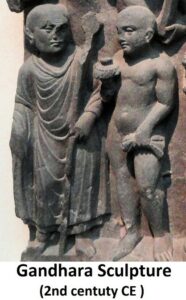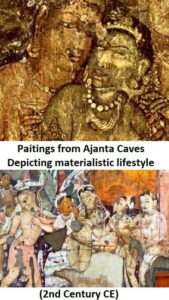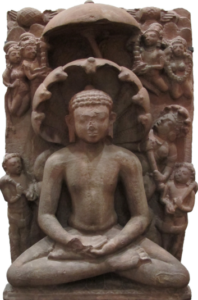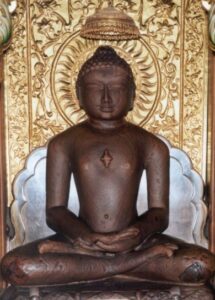Religious Traditions: Shramanism, Jainism, and Buddhism – UPSC Notes
In the post-Vedic period, a significant change occurred in the nature of Religious practices in India. We see the emergence of new religious movements, such as Jainism and Buddhism, which impacted society, the polity and the administration for centuries to come.
The Shramana Tradition
- The Shramana Tradition
- Causes of its Emergence
- Various Schools of Shramanism:
- Common features of Shraman tradition:
- Jainism
- Origins of Jainism
- Philosophy and Teachings of Jainism
- Sects/Schools of Jainism
- Jaina Councils
- Jaina Literature
- Decline of Jainism
- Buddhism
- Buddhist Schools of Philosophy
- Bodhisattvas in Buddhism
- Literature
- The Decline of Buddhism in India
- Contribution and influence
‘Shramana’ means striving and working hard by living a life of austerity in search of the ultimate truth. The Shramanas were people in the 1st millennium BCE who had left their homes and wandered in the forests in search of the truth about life and the universe.
Many religious movements like Buddhism, Jainism, Lokayat, Ajivika etc., emerged from this movement. They emerged as a reaction to the Vedic religion, which was increasingly becoming ritualistic and corrupt.
Causes of its Emergence
- Varna System: Brahmanas claimed the highest status in the post-Vedic society. Kshatriyas reacted strongly against the Brahman domination, which created tensions.
- Cumbersome Religious Practices: Vedic religious practices, sacrifices and rituals became increasingly more elaborate and expensive for the people. Vardhman Mahavira and Gautam Buddha both belonged to the Kshatriya clan, and both disputed the authority of the Vedas.
- Expansion of agriculture: After the introduction of the Iron-tipped ploughshare, the use of bullocks became essential. The Vedic practice of Animal sacrifices thus stood in the way of the progress of new agriculture.
- Change in Economic Position of Vaishyas: Many new cities emerged, facilitating trade and commerce and adding to the Vaishyas’ importance. Moreover, they were attracted to the new religions which preached non-violence and peace. Further, the Dharmasutras (Law books) denounced money lending, again repelling Vaishyas from the Vedic religion.
- Reaction Against Emerging Material Culture: Old-fashioned people did not like the emerging culture of the accumulation of coins, new dwellings, new dresses, and new transport systems, which amounted to luxury, and created social inequalities. On the other hand, Buddhism and Jainism preferred simple, puritan ascetic living, which appealed to the masses.
Various Schools of Shramanism:
|
1. Ajivika or The Fatalists Mahakassapa (Left) meets a naked Ajivika Ascetic (Right).
|
|
|
2. Lokayatas or The Materialists/Atheists
|
|
| 3. Ahetuvadins or The Amoralists |
|
| 4. Ajnanis(Agyanis) or The Agnostics |
|
| 5. Sashvatvadins or The Eternalists |
|
Common features of Shraman tradition:
- Nastika Philosophy: These are those schools of thought which did not believe in the authority of Vedas. In this context, they are known as Heterodox schools/Nastika schools of thought.
- Protest against Brahmanism: These movements emerged as a protest against Brahmanical ideas, as we have seen before.
- Less ritualistic: In the initial days, ritualism was not so profound in Jainism and Buddhism.
- Open to all: It did not require Brahmanas to perform elaborate rituals.
- The emergence of new Philosophical ideas: Such as prominence given to Materialism, the Doctrine of Niyati(Fatalism), Karma etc.
Jainism
Jainism comes from the word ‘Jina’, meaning the conqueror. It refers to a person who has conquered the self. It is the one who has been freed from all desires of life.
Origins of Jainism
- According to Jaina traditions, twenty-four Tirthankaras were responsible for the origin and development of the Jaina religion and philosophy, starting from Risabhadeva to Mahavira. The term Tirthankara means ‘founders of the faith’.
- Of these, the identity of the first twenty-two Tirthankaras is of doubtful historicity. However, Buddhist works confirm the historicity of Parsvanatha and Mahavira.
|
Parsvanatha
|
|
|
Vardhamana Mahavira (540 – 468 BCE)
|
|
Philosophy and Teachings of Jainism
- Rejection of God: Jainism rejects the idea of an ultimate creator as well as the authority of the Vedas. The universe is a natural phenomenon and does not require the concept of god to explain its existence.
- Soul in every object: Every material object possesses a soul, according to Jainism. Therefore, one must not harm even the smallest of beings.
- Jaina Doctrine of Karma: The Jains believe in the doctrine of Karma and the transmigration of the soul. Karma is envisaged as a sticky substance that infiltrates the body and binds it to the world.
- Salvation: According to Jainism, salvation or ‘Moksha’ is achieved upon getting rid of the influence of old Karma. It relieves the soul from the cycle of birth and rebirth.
- Five Vows of Jainism or the Panchvrata prevents new Karma from accumulating and thus clears the path for liberation. These five vows are:
- Satya (Truth)
- Ahimsa (Non-violence)
- Aparigraha (Non-possession)
- Asteya (Non-stealing)
- Brahmacharya (celibacy).
- Jaina advise us to lead a pure life guided by the three-fold path (Triratna) of:
- Right faith,
- Right knowledge and
- Right conduct.
- Anekantavada: is the theory of plurality which emphasises that the ultimate truth is infinitely complex and has multiple aspects. Therefore, no person can be ultimately correct about anything.
- Syadavada: It is a concept of relative judgment. It implies that knowledge which looks correct from one point of view might be false from others’ point of view. Thus, no single opinion can be called complete knowledge in its entirety.
- Lifestyle: They advocated extreme non-violence and practised starvation (Sallekhana), nudity, and self-mortification, taking austerity to an extreme level.
- Varna system: Unlike Buddhism, Jainism did not reject the Varna system. However, they did emphasise the aspect of equality.
Sects/Schools of Jainism
After the death of Mahavira, the Jaina community split into several sects. Of these, two important sects emerged, the Svetambaras (wearers of white clothes) and the Digambaras (‘wearers of the sky’ or ‘the naked’).
Reason for Factionalism: Once, a prolonged famine in Magadha compelled a group led by Jain monk Bhadrabahu to move to South India. During that time, the south Indian group stuck to the strict practices while the group in Magadha adopted a more flexible attitude towards the Jaina discipline.
The two groups eventually got into a dispute due to such changed practices. This led to a division in Jainism.
| Digambara (The ‘sky clad’) | Svetamabara (The ‘White clad’) | |
| Position on Clothes | To achieve nirvana (liberation), one must renounce everything, including clothes. | Nudity is not essential to attain liberation. |
| On Women | Women require to be first reborn as a man to attain liberation. | All individuals, including women, are equally capable of achieving liberation. |
| On Having Possession | Monks cannot have any possessions except three things, Picchi (Broom), Kamandal (water pot), and shastra (books). | Shvetambara monks are allowed to possess 14 specified things |
| On idols | Digambara idols are undecorated and naked, having downcast eyes. | Svetambara idols are decorated with jewels, wearing loin-cloth with prominent staring eyes. |
| On scriptures | They hold the opinion that original texts of Jainism were lost long ago. | They believe they have the original scriptures, even though they are incomplete. |
| On Mahavira’s Marriage | They believe that Mahavira was not married. | They believe that Mahavira was married to princess Yashoda before renunciation. |
Later on, various other factions appeared as shown in the following diagram. We shall discuss them in Art and Culture – Religions of India.
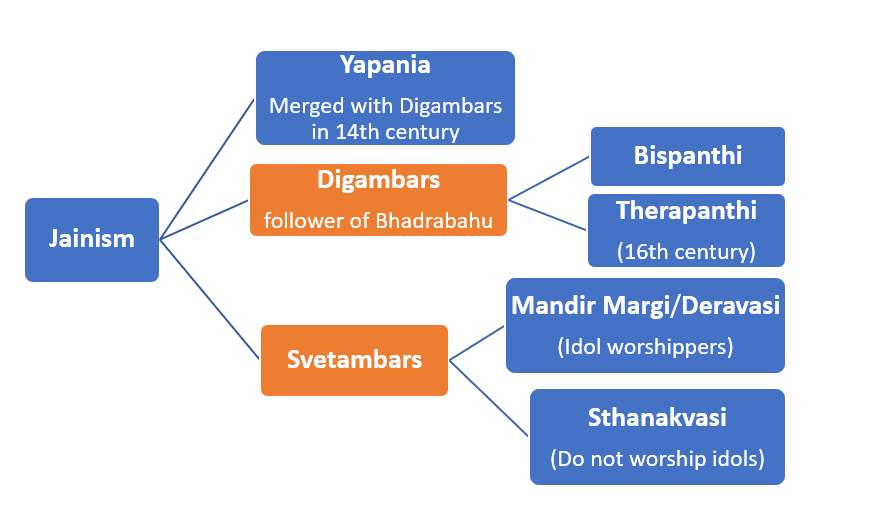
Jaina Councils
Two Jaina councils have been held in History. The First Jaina council was held in Patliputra in 300BCE by the followers of Bhadrabahu.
The second Jaina council was held much later in Valabhi in 512BCE.
| First Jaina council (300 BCE) | Second Jaina council (512 CE) | |
| Location | Pataliputra | Vallabhi |
| Chairperson | Sthulabhadra | DevadhiKshmasramana |
| Patron | Chandragupta Maurya | No great patron |
| Output | Compilation of 12 Angas | The Final compilation of 12 Anga and 12 Upanga |
Jaina Literature
- Ancient Jain texts were generally written in Prakrit.
- There are two types of Jaina texts:
- Agam Sutras or Canonical Literature: consists of many sacred texts written in the Ardha-magadhi, a form of Prakrit language.
- Non-Agam Literature: consists of commentary on the Agam literature and independent works compiled by ascetics and scholars.
- Further, the teachings of Tirthankara before Mahavira were known as Purva Sutras.
- The Digambers today believe that the original Jain text has long been lost. However, Shvetambers believe that some portion of the text is preserved with them.
- The canon is divided into six sections and contains either forty-five or forty-six books.
- The twelve Angas or limbs.
- The twelve Upangas, or secondary limbs
- The ten Painnas, or ‘Scattered-pieces’.
- The six Cheya-Suttas
- Individual texts (two)
- The four Mula-Suttas
Decline of Jainism
- Lack of royal patronage: Rulers like Bimbisara, Ajatasatru, Udayin, and Kharavela had extended royal patronage to Jainism. But later on, the spread of Buddhism captured the space occupied by Jainism.
- Lack of missionary zeal: Unlike Buddhists, Jain monks were less enthusiastic about the spread of Jainism, and once the Royal patronage waned, it declined.
- Extreme austere lifestyle: Extreme austerity was practised by the Jain monks. This led to the alienation of people from the religion.
- Renunciation of certain occupations: For example, Jainas couldn’t be agriculturalists as it involved showing cruelty towards pests.
- The rise of Buddhism: This was perhaps the most critical factor behind the decline of Jainism. The royal patronage enjoyed by Jainism shifted towards Buddhism. Since Buddhism advocated simple living and a middle path, it was accepted by the masses.
- The rise of Bhakti movement – Vaishnavism, Saivism and Shaktism was another reason behind the decline.
Buddhism
Origin of Buddhism
- Gautama Buddha (566-486 BCE), also known as the “Light of Asia”, is the founder of Buddhism. He was born as Siddhartha to Shuddhodhana, a Shakya clan prince and Kshatriya Princess Maya in Lumbini.
- At the age of 16, Siddhartha got married to Princess Yashodhara and lived a royal life away from the harsh realities of life.
- At the age of 29, a turning point came in his life when during an excursion outside his royal palace, he saw that humans are subject to old age, sickness, and death. For the first time in his life, he realised that a life of self-indulgence cannot give him ultimate happiness.
- Following this incident, he gave up the princely life and became a wandering ascetic, practising extreme self-mortification for nearly six years. But all this hardship didn’t bring him any closer to true happiness.
- Ultimately, he realised that he must avoid both extremes of pleasure and pain to reach the ultimate knowledge. This is what he calls a middle path.
- Thus, he accomplished enlightenment (Bodhi) under a banyan tree at Bodha Gaya in Bihar and became a Buddha (the enlightened one) in 528BCE.
- After this, he started giving sermons to those who wished to become his students. His first sermon, known as Dhammachakkapavattana, or setting in motion the wheel of Dharma, was held in Sarnath.
- He achieved mahaparinibbana or mahaparinirvana (final liberation), i.e. death in Kushinagar.
Philosophy and teachings of Buddhism
- Against Philosophical speculations: The Buddha was least interested in metaphysical discourses and called such debates indeterministic.
- The four Noble Truths: The essence of the Buddha’s teachings is contained in the Four-noble truth.
- Dukkha: There is ‘Suffering’.
- Dukkha Samudaya: There is a cause of ‘Suffering’.
- Dukkha Nirodha: There is a cessation of ‘Suffering’.
- Dukkha Nirodha-Magga: There is a path leading to the end of ‘Suffering’.
- The Noble Eightfold Path in Buddhism is the path of salvation given by Buddha. It is contained in the fourth noble truth as a means to destroy suffering.
- Right View (Samyak-dristi)
- Right Aspirations (Samyka-sankalpa)
- Right Speech (Samyak-vac)
- Right Conduct (Samyak-karma)
- Right Livelihood (Samyag ajiva)
- Right Effort (Samyak vyayama)
- Right Awareness (Samyak Smrti)
- Right Concentration (Samyak Samadhi)
- The Doctrine of Karma: In the Buddhist tradition, Karma refers to action driven by intention, which leads to future consequences. All Karma creates a tendency to produce an effect. Therefore, all actions have consequences.
- The Doctrine of Dependent Origination (Pratitya-Samutpada): It is central to Buddhist philosophy and is connected to the second noble truth – suffering has a cause (Dukkha Samudaya). According to this principle, all events have a cause, which means this suffering, too, has a cause. The principal cause of Dukha is our ignorance, which creates a harmful Karmic effect on us, pulling us into a cycle of birth and rebirth.
- The doctrine of Madhyama Pratipada or Middle path: Buddha advises us to follow a middle path betweentwo extremes of indulgence in worldly pleasure and the practice of strict abstinence and asceticism.
- The Rejection of god: Hinayana rejects the concept of a creator. According to Buddhists, the world is driven by the law of Karma, not by god. However, Mahayana later represented the Buddha himself as the god.
- The no-soul theory (Anattavada): Refers to the doctrine of “non-self”. Early Buddhists did not believe in a permanent soul but instead believed in a temporary, ever-changing soul. This was a controversial doctrine as a permanent soul is necessary to register the effects of the past Karma according to traditional beliefs.
- Focus on Ethics: Buddha was concerned about ethical living, applicable to all sections of people.
- Caste system: Buddhism does not practise the caste system. The Sangha had members from all castes. However, they did not try to abolish the institution of caste and maintained the status quo.
Buddhist councils and the Development of Buddhism
-
- After the death of Gautam Buddha, several controversies regarding the rules of monastic life and Buddhist Philosophy broke, which required various councils to resolve.
- In the very first Buddhist council, two Pali canons (book of rules) – Sutta Pitaka (Buddha’s teaching) and Vinaya Pitaka (rules of monastic life) were composed and agreed upon by various groups.
- However, In the 2nd Buddhist council, the ‘elders’ wanted to purify the Buddhist movement by introducing strict rules of monastic life. They were not satisfied with the Vinaya Pitaka formulated in the first Buddhist council. This led a group to break away and form Mahasamghika. Eventually, they came to be known as Mahayana or the larger vehicle.
-
- Sthavirvada was the name given to the “Doctrine of Elders”.
- In the 3rd Buddhist council, held by the Sthavirvadins, the Abhidhamma Pitaka was formed, which contained the philosophical doctrine of Buddhism.
-
- Another faction of Buddhists, Sarvastivadins, held the 4th Buddhist council and adopted Sanskrit to create their literature, replacing the Pali language. They created a Sanskrit version of Abhidhamma Pitaka and a Mahavibhasa(commentary on Abhidhamma).
Buddhist Schools of Philosophy
-
-
- Since Buddha himself did not want to indulge in philosophical speculations, the Mahasamghika distanced itself from the various schools of Hinayana.
- However, from the first century AD onwards, Mahasamghika itself produced various philosophies, such as Shunyavada and Vijnanavada (Vigyanavada).
-
The Distinction between Hinayana and Mahayana
All of the above schools of Buddhism can be clubbed into Hinayana and Mahayana. Following are the major differences between the two:
| Hinayana | Mahayana | |
| Meaning | It translates as ‘the lesser Vehicle.’ | It translates as ‘the greater vehicle’, aiming to carry a greater number of people through the troubled waters of Sansaar. |
| Path to salvation | Dry Asceticism: An individual can attain salvation through self-discipline & meditation. | Salvation can also be attained through the means of faith and devotion to Buddha. |
| Liberation | ‘Nibbana’ leads to the extinction of miseries and being blown out of existence. Thus it has a negative connotation. | ‘Nirvana’ is the positive attainment of ananda(bliss). Thus it has a positive connotation. |
| Ideal saint | An ‘Arhat’(saint) strives for their own salvation without worrying about others (Atma-Dipo-Bhava) | A ‘Bodhisattva’(saint) defers their own salvation for the sake of others. |
| Belief | It believes in no soul and no god. | They believe in the transcendent (Parmartha). |
| Idol worship | It doesn’t believe in idol worship and the deification of Buddha. | They consider Buddha as a god and worship his idols. They also worship the Bodhisattvas. |
| Language | It adopts the Pali language. | It is open to the Sanskrit language as well. |
| Patron | Patronised by Ashoka. | Patronised by Kushan ruler Kanishka. |
| Spread | It is found in Sri Lanka, Myanmar, Thailand and other parts of South-East Asia. | It is spread across Japan, China, Vietnam, Korea, Taiwan, Singapore, Nepal, Tibet, Mongolia, and Bhutan. |
Bodhisattvas in Buddhism
Bodhisattvas are individuals who are on the path to becoming Buddha or attaining salvation. They can defer their own salvation to help others through the troubled waters of the world.
Following is the list of important Bodhisattvas:
| Avalokiteshvara/ Padmapani | The Bodhisattva of compassion and the most universally acknowledged Bodhisattva in Mahayana Buddhism. Usually depicted as holding a lotus and is white in colour. |
| Vajrapani | The Bodhisattva of power and great energy. |
| Manjushri | He is associated with Prajna (transcendent wisdom) in Mahayana Buddhism. |
| Samantbhadra | He is associated with practice and meditation. Together with the Buddha and Manjushri, he forms the Shakyamuni trinity in Buddhism. |
| Sarvanivarana-Vishkambhin | He purifies the internal and external wrongdoings and obstructions that people face on their path to enlightenment. |
| Akashagarbha | He is associated with the great element (mahābhūta) of space. |
| Kshitigarbha | He is known for saving the souls of all beings between Buddha’s death and the age of Maitreya (future Buddha). |
| Maitreya | Regarded as the future Buddha, who would appear on Earth in the future and achieve complete enlightenment and teach the pure Dharma. |
Literature
Tripitaka (also called Tipitaka in Pali),or three baskets, written in the Pali language, are the most important texts in Buddhism.
-
-
- Sutta Pitaka: It is the largest of the three Pitaka. It contains discourses, lessons, and quotations allegedly taken directly from the Buddha. Ananda, a student of Buddha, recited it after the Death of Buddha.
- Vinaya Pitaka: It contains monastic rules for monks and nuns. Upali, another student of Buddha, recited it.
- Abhidhamma Pitaka: It contains a philosophical treatise on Buddhism. Since both Hinayana and Mahayana have different philosophical interpretations, they have different versions of their Abhidhamma. Further, Sarvastivada and Mahayana have produced their Abhidhamma in Sanskrit instead of Pali.
-
Apart from the Pali canon, a separate Abhidhamma was written by the Sarvastivadins, as seen in the Fourth Buddhist Council.
The Decline of Buddhism in India
-
-
- Division among the Buddhists: Buddhism got divided into factions like ‘Hinayana’, ‘Mahayana’, ‘Vajrayana’, ‘Tantrayana’ and ‘Sahajayana’, which led Buddhism to lose its originality.
- Corruption in Buddhist Sanghas: With time, the monks and followers came to be drawn toward luxury and self-indulgence.
- The decline in royal patronage: Patronage gradually stopped after Pushyamitra Sunga, a Brahmin king who replaced later Mauryans. Harshavardhan was the last great patron of Buddhism.
- Reform in Hinduism: Due to the criticism from Sramana traditions, Hinduism started to re-organise itself, simplifying its rituals and accepting Non-violence. Eventually, even Buddha was accepted as an incarnation of Vishnu.
- Use of Sanskrit Language: Pali and Prakrit were replaced bySanskrit, which was difficult for common people to understand.
- Idol worship: Idol worship by the Mahayana sect was against the basic principles of Buddhism, which brought it closer to Hinduism.
- Role of Hindu saints: Bhakti Saints like Adi Shankaracharya played a vital role in the revival of Hinduism by opening the doors of Hinduism for all.
-
Contribution and influence
-
- Concept of non-violence: It emphasises non-violence and the sanctity of animal life.
- Monastic system: The Buddhist monks followed strict codes of discipline. Each monastery had a head who was elected by the monks themselves. Gradually this monastic system was adopted by Hinduism.
- Development of Art: Buddhist art and sculpture coincided with the spread of Buddhism. Many stupas, chaityas and pillars were constructed. Events from the life of Buddha and the Bodhisattvas were the most popular themes in the Gandhara and Mathura schools of art. Magnificent paintings in Ajanta and Ellora survived the test of time and can still be seen.
- Development of literature: The Tripitakas and Jataka are the most important literary works of the Buddhists. Further, famous philosophical texts and commentaries like Mahavibhasha were composed.
- Established relations with foreign countries: The Buddhist Missionaries spread the teachings of Buddha from the 3rd century BCE onwards to foreign lands. For example, Ashoka sent his son and daughter to Sri Lanka. In return, foreign Buddhist pilgrims and students came to India in search of knowledge.
- Centre of learning: Buddhism promoted education through famous residential universities like Nalanda, Taxila, Vikramasilan, Nagarjunakonda, and Valabhi.
- Simplification of Religion: The greatest contribution of Buddhism was the establishment of a simple religion which could be easily understood and followed by ordinary people. There were no complex rituals, sacrifices or yajnas.
- Less discriminatory: there was lesser discrimination based on caste as well.


